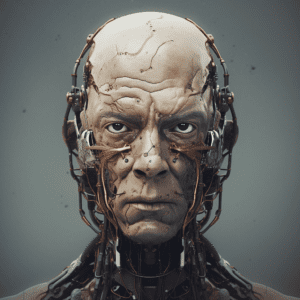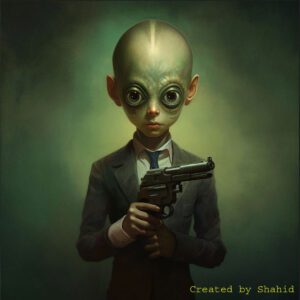What is Artificial Intelligence?
Artificial Intelligence (AI) refers to the simulation of human intelligence in machines that are programmed to perform tasks that would typically require human intelligence. It involves the development of computer systems that can perform tasks such as speech recognition, decision-making, problem-solving, learning, and understanding natural language.
How AI generates images from scratch?
AI can generate images from scratch using a technique called generative modeling, with one popular approach being Generative Adversarial Networks (GANs)…
Does Ai generated Images resemble to somebody?
AI-generated images can resemble somebody or something, depending on the training data and the objective of the AI model…
What is Artificial Intelligence?
Artificial Intelligence (AI) refers to the simulation of human intelligence in machines that are programmed to perform tasks that would typically require human intelligence. It involves the development of computer systems that can perform tasks such as speech recognition, decision-making, problem-solving, learning, and understanding natural language.

AI can be broadly categorized into two types:
- Narrow AI and
- General AI.
Narrow AI: Also known as weak AI, Narrow AI is designed to perform specific tasks within a limited domain. Examples include virtual personal assistants like Apple’s Siri or Amazon’s Alexa, recommendation systems used by online platforms, and computer vision systems used in facial recognition or object detection. What is Artificial Intelligence?
General AI: Also known as strong AI or AGI (Artificial General Intelligence), General AI refers to AI systems that possess human-level intelligence and can understand, learn, and apply knowledge across various domains. General AI aims to replicate human cognitive abilities, including reasoning, problem-solving, and emotional intelligence. However, achieving General AI remains an ongoing area of research and development.

AI algorithms utilize various techniques, including machine learning, deep learning, natural language processing (NLP), computer vision, and robotics, among others. Machine learning involves training algorithms with large datasets to learn patterns and make predictions or decisions without being explicitly programmed. What is Artificial Intelligence?
Deep learning, a subset of machine learning, uses artificial neural networks with multiple layers to learn and represent complex patterns.
Applications of AI are widespread and continue to expand across various industries, including healthcare, finance, transportation, manufacturing, entertainment, and more. AI systems are used for tasks like medical diagnosis, fraud detection, autonomous vehicles, recommendation systems, customer service chatbots, and even creating art and music.
It’s important to note that while AI has seen significant advancements, there are also ongoing discussions surrounding ethical considerations, privacy concerns, and the potential impact on the job market as automation increases.
What is Ai generated image?
An AI generated image is an image that is created by a computer program. The program uses artificial intelligence (AI) to learn from a large dataset of images and then to generate new images that are similar to the ones it has learned from. What is Artificial Intelligence?

AI generated images can be used for a variety of purposes, such as:
- Art: AI generated images can be used to create new and unique forms of art.
- Design: AI generated images can be used to create new and innovative designs for products, websites, and other applications.
- Research: AI generated images can be used to study the visual world and to develop new AI algorithms.
- Entertainment: AI generated images can be used to create new and exciting forms of entertainment, such as virtual reality and augmented reality experiences.
AI generated images are still in their early stages of development, but they have the potential to revolutionize the way we create and use images.
How AI generates images from scratch?
AI can generate images from scratch using a technique called generative modeling, with one popular approach being Generative Adversarial Networks (GANs).
GANs consist of two neural networks: What is Artificial Intelligence?
- a generator network and
- a discriminator network. Here’s a simplified overview of how the process works:

Training Phase:
The generator network takes random noise as input and generates an image.
The discriminator network receives both real images from a dataset and images generated by the generator network as input.
The discriminator’s task is to determine whether the input image is real or generated.
The generator’s objective is to generate images that the discriminator cannot distinguish from real images.
Both networks are trained in an adversarial manner, meaning they try to outperform each other.
Gradually, through iterations, the generator network learns to generate more realistic images, and the discriminator network becomes better at distinguishing between real and generated images.
Generation Phase:
After training, the generator network can generate new images by taking random noise as input.
The generator uses the learned patterns and structures from the training data to produce an image.
By adjusting the input noise or providing specific input conditions, it’s possible to control the characteristics of the generated image (e.g., changing the face of a generated person, modifying the pose of an object, etc.). What is Artificial Intelligence?
It’s worth noting that GANs are just one approach to generating images from scratch. There are other techniques as well, such as Variational Autoencoders (VAEs) and Autoregressive models, each with its own advantages and limitations. Additionally, the quality and realism of generated images can vary based on the complexity of the dataset, the architecture of the networks, and the training process.
The field of generative modeling is constantly evolving, and researchers are continually exploring new techniques to improve the quality and diversity of generated images.
Does Ai generated Images resemble to somebody?
AI-generated images can resemble somebody or something, depending on the training data and the objective of the AI model. If the AI model is trained on a dataset consisting of images of specific individuals, such as celebrities or public figures, there is a higher chance that the generated images might resemble those individuals.
However, it’s important to note that AI-generated images are not exact replicas of real individuals. They are synthesized based on patterns and characteristics learned from the training data. The level of resemblance can vary, and the generated images may not capture all the subtle details and nuances that make each person unique.
Furthermore, AI models can also generate entirely new and fictional images that do not resemble any specific person. These images can be creative and novel, combining features and elements from different training samples or inventing new visual representations.

It’s crucial to approach AI-generated images with caution and understand that they are artificial representations rather than exact copies of real individuals. Ethical considerations and responsible usage of AI-generated images are important to avoid potential misuse or misrepresentation.
Does AI generated content violate any copyright?
The topic of AI-generated content and copyright is complex and can vary depending on the jurisdiction and specific circumstances. It’s important to consult legal professionals for accurate and up-to-date advice in your jurisdiction. However, here are some general considerations:
Originality: Copyright protection typically applies to original creative works that exhibit a sufficient level of creativity or human authorship. In the case of AI-generated content, where the content is entirely computer-generated without human involvement, questions may arise regarding the eligibility for copyright protection. What is Artificial Intelligence?
Human Involvement: If human creators are involved in the process of training or fine-tuning the AI model, they may have a claim to copyright ownership over the generated content. For example, if an artist uses AI tools as part of their creative process and contributes to the AI-generated artwork, they may have copyright protection over that specific output.
Data Sources: AI models are often trained on existing datasets, which may include copyrighted materials. If the AI model generates content that resembles or incorporates copyrighted works from the training data, it can raise concerns regarding potential infringement. However, the extent of transformation and creativity in the generated content could also be relevant factors.
Derivative Works: If AI-generated content is considered a derivative work based on copyrighted material, it may require permission from the copyright holder of the original work. The threshold for what constitutes a derivative work can vary, and legal interpretations may differ. What is Artificial Intelligence?
Public Domain and Fair Use: If the AI-generated content falls within the public domain or qualifies for fair use under copyright law, it may not violate copyright. However, determining whether fair use applies can be subjective and depend on the specific context.
It’s essential to stay informed about the legal developments in AI and copyright and consult legal professionals for advice on specific situations. As AI technology progresses, laws and regulations may evolve to address the complexities surrounding AI-generated content and copyright. What is Artificial Intelligence?

How and from where the Artificial intelligence gathers data to generate new content?
Artificial intelligence gathers data from various sources to generate new content. The specific sources can vary depending on the type of AI model and the task it is designed to perform. Here are some common ways AI gathers data: What is Artificial Intelligence?
Public Datasets: AI models often rely on large, publicly available datasets that are curated and made accessible for research purposes. These datasets may include text, images, audio, or other types of data. Examples of popular public datasets include Image Net for computer vision and the Common Crawl for web text. What is Artificial Intelligence?
Web Scraping: AI models can be trained on data collected by web scraping, which involves automatically extracting information from websites. This data can include text, images, user-generated content, or any other publicly available information on the web. What is Artificial Intelligence?

Company-Specific Data: Some AI models are trained on proprietary or company-specific datasets. For example, AI systems used in recommendation engines or personal assistants can gather data from users’ interactions with platforms or devices. What is Artificial Intelligence?
User-Generated Content: AI models can be trained on user-generated content, such as social media posts, reviews, comments, or any data that users publicly contribute to online platforms. This data can be used to generate insights, sentiment analysis, or personalized recommendations.
Sensor Data: AI models employed in Internet of Things (IoT) devices can gather data from sensors, such as temperature sensors, cameras, microphones, or accelerometers. This data can be used for various purposes, such as environmental monitoring, activity recognition, or predictive maintenance. What is Artificial Intelligence?
Human-Curated Data: In some cases, humans manually curate or annotate datasets specifically for AI training. For example, in computer vision, humans might label images to indicate the presence of objects or to provide semantic segmentation masks. What is Artificial Intelligence?
It’s important to note that the data gathering process should comply with legal and ethical considerations, such as data privacy, copyright, and user consent. Responsible AI practitioners ensure that the data used for training models is obtained and used in a lawful and ethical manner. What is Artificial Intelligence?
Can AI be banned in future?
The question of whether AI can be banned in the future is a matter of speculation and depends on various factors, including societal, ethical, and regulatory considerations. It is possible that certain applications or uses of AI could be restricted or regulated in the future due to concerns about safety, privacy, bias, or potential misuse.

Here are a few points to consider:
Regulation: Governments and regulatory bodies have the authority to impose restrictions or regulations on AI technologies. They may introduce laws, policies, or standards to ensure the responsible development, deployment, and use of AI. We have already seen efforts to regulate AI in areas such as autonomous vehicles, facial recognition technology, and data privacy.
Ethical Concerns: As AI technology advances, ethical concerns surrounding its use become more prominent. Discussions around AI ethics often revolve around issues like transparency, accountability, fairness, and the potential impact on human rights. If the deployment of AI systems raises significant ethical concerns, there may be calls for restrictions or regulations.
Safety and Security: AI-powered systems can have implications for safety and security. If there are risks associated with certain AI applications, such as autonomous weapons or AI systems with potential for widespread harm, there may be efforts to ban or tightly regulate those specific uses. What is Artificial Intelligence?
Public Perception and Backlash: Public sentiment and societal attitudes towards AI can influence policy decisions. If there is a widespread perception that AI poses significant risks or if there are instances of AI-related incidents leading to negative outcomes, public pressure could drive calls for restrictions or bans.
International Cooperation: The global nature of AI development and deployment necessitates international cooperation and collaboration. Discussions among nations and international bodies can shape policies and agreements regarding the responsible use and regulation of AI technologies. What is Artificial Intelligence?
It’s important to note that AI encompasses a broad range of technologies and applications, and the response to AI will likely be nuanced. Rather than an outright ban, it is more likely that specific applications or uses of AI may face restrictions, regulations, or guidelines to ensure responsible and ethical practices. What is Artificial Intelligence?
Can AI mark an end to human creativity?

AI does not mark an end to human creativity. While AI has shown remarkable advancements in various creative domains, such as generating artwork, composing music, or writing stories, it is important to recognize that AI-generated content is still based on patterns and information learned from human-generated data.
Human creativity encompasses a range of qualities, including imagination, emotional expression, subjective interpretation, and originality. These aspects involve complex cognitive processes, personal experiences, emotions, and social contexts that make human creativity unique and multifaceted. What is Artificial Intelligence?
AI, on the other hand, operates based on algorithms and statistical patterns. It can learn from existing data and generate new content based on those patterns, but it lacks subjective experiences, emotions, and the ability to truly understand the meaning and context behind creative expressions. What is Artificial Intelligence?
While AI-generated content can be impressive and even aesthetically pleasing, it often lacks the depth, intention, and nuanced qualities that human creativity brings. Human creators can draw from their personal experiences, emotions, and unique perspectives to produce original and thought-provoking works that go beyond what AI can currently achieve. What is Artificial Intelligence?
Instead of replacing human creativity, AI has the potential to enhance and augment human creative endeavors. AI tools can be used as aids or collaborators in the creative process, providing inspiration, generating ideas, or assisting with repetitive tasks, allowing human creators to focus on higher-level conceptualization and unique contributions. What is Artificial Intelligence?
Ultimately, human creativity is a rich and fundamental aspect of our existence, and AI, as a tool, can complement and extend human creative capacities, but it cannot replace the depth and richness of human creative expression. What is Artificial Intelligence?
Can AI work on its own once equipped with full human like knowledge?
The concept of AI working on its own once equipped with full human-like knowledge falls into the realm of Artificial General Intelligence (AGI). AGI refers to AI systems that possess human-level intelligence across a broad range of tasks and domains. While there is ongoing research and speculation about AGI, achieving it remains a significant challenge and an open question in the field of AI. What is Artificial Intelligence?
The idea of an AGI capable of independently working on its own, equipped with full human-like knowledge, is a topic of debate and speculation. Some experts believe that it may be possible in the future, while others have concerns about the feasibility and implications of such a scenario.
Creating an AGI that can autonomously work on its own entails not only developing advanced algorithms and cognitive capabilities but also addressing critical aspects such as consciousness, self-awareness, and ethical decision-making. These are complex and multifaceted challenges that researchers are actively exploring but have yet to solve.
Additionally, the question of whether an AGI would be able to acquire “full human-like knowledge” raises philosophical questions about the nature of knowledge, subjective experiences, and the acquisition of human consciousness. What is Artificial Intelligence?
It’s important to note that the development of AGI is an ongoing area of research, and predicting its future capabilities is speculative. While AI has made significant advancements in specialized domains, creating an AGI that can independently work on its own and possess full human-like knowledge remains an ambitious and uncertain goal. What is Artificial Intelligence?





